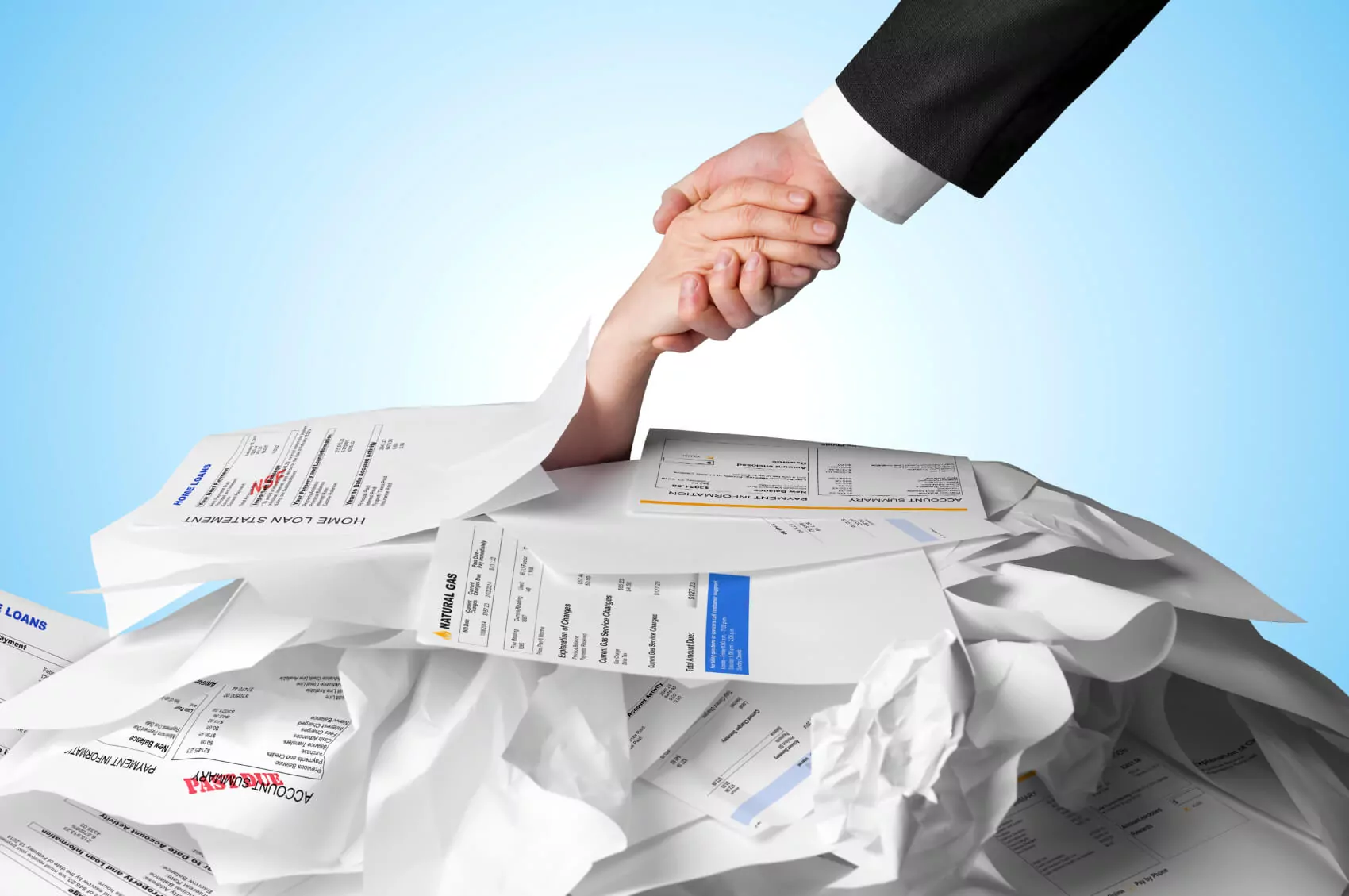If you’re tired of collection calls, minimum monthly payments that never seem to pay off your debt and constantly struggling to make ends meet, then a debt settlement program may be the solution you need. These programs help you get out of various types of debt for less than you owe, without the hassle of trying to negotiate on your own. This guide explains how a debt settlement program works, so you know what to expect.
What is a debt settlement program?
A debt settlement program is a professionally assisted form of debt relief that settles debts for less than you owe. You work with a debt settlement company to generate funds, so they can negotiate a one-time lump-sum payment to each creditor. You pay a portion of each balance that you owe and in exchange, the creditor or collector discharges the remaining balance. Settlements reached this way are listed as paid as agreed in your credit report.
How a debt settlement program works step by step
Step 1: Free evaluation
Debt settlement companies are not permitted to charge any fees until they’ve successfully negotiated at least one settlement on your behalf. So, every debt settlement program starts with a free evaluation to see if you’re a good fit for the program.
A debt resolution specialist will ask you to tell them about your situation:
- How did your challenges with debt start?
- What debts do you owe?
- Is your budget balanced or, if not, how much are you falling behind each month?
The representative will also request your Social Security number, so they run a check on your credit report. This will allow them to see where your credit really stands, although they will also ask if you know your credit score.
The purpose of this free evaluation is to see if you’re a good candidate for settlement. As long as you contact a reputable company that’s a member of a recognized trade association, such as the American Fair Credit Council, then they will only recommend settlement if it’s the right fit for your financial situation. Otherwise, they may direct to you other solutions that would be better for your needs.
Debt.com can match you with an accredited debt relief company that can help you settle your debts for less than you owe.
Step 2: Decide which debts you want to include
Once you and the debt settlement rep decide the program is the right fit, you work out the details of your program, starting with which debts you want to include.
There is no requirement that you include all of your debts or even all of your credit cards in a settlement program. You may choose to leave certain debts out, either because you want to maintain accounts that are already current or because you plan to use a different solution for a specific account.
Types of debt you can include in a debt settlement program
- General-purpose credit cards
- Store credit cards
- Charge cards
- Collection accounts, either from charged off credit cards or even things like unpaid utilities
- Unpaid medical bills and medical collections
- Unsecured personal loans, not including student loans
- Deficiency balances on car repossessions
Step 3: Set up a settlement escrow account
In order to generate the funds you need to make settlement offers, the debt settlement company will set up an escrow account. This is a secure account where your funds will be kept until settlements are ready to be paid.
For the most part, people who are looking to settle debt don’t just have large lump sums of cash on hand to make settlement offers. After all, if you had the cash, you’d probably be using it to pay off your debts!
This means that in most cases, you’ll need to contribute a monthly set aside to the escrow account. This is basically a low monthly payment that should be a smaller percentage of what you’re currently paying to your individual creditors. The goal is to generate the money the company needs to make settlements as quickly as possible without creating undue stress on your budget.
Once you determine the monthly set aside you can afford, then the resolution specialist will send you an electronic docusign to get your signature on the final program agreement. Each month, you make the monthly payment into the escrow account.
Step 4: Once you have the funds, the settlement company gets to work
As soon as you have funds, the settlement company calls your creditors to negotiate each settlement. They negotiate to get you out of the debt for a percentage of what you owe. It’s the company’s job to try and get you the lowest settlement amount possible. Once both sides reach an agreement, the creditor prepares a formal settlement agreement.
You sign the settlement, then the debt settlement company pays the creditor out of your escrow account. They also take their fees out of your escrow.
How do debt settlement fees work?
By law, debt settlement companies cannot charge any fees until a settlement is successfully achieved. Then, the company takes its fees out of the escrow account. Settlement fees are typically either a set percentage of the original amount you owe or ideally, a percentage of the amount of the debt you save (if your original loan was $10,000 and your settlement company helps you settle for $6,000, they would charge you a percentage of that $4,000 you are no longer on the hook for).
The latter fee structure ensures that settlement companies work to get you the lowest amount possible because their fees aren’t tied to your final payment. Make sure to check the percentage a company uses for fees before you sign up for the program!
Step 5: Complete your program and make a plan for recovery
Each debt that’s settled will be reported to the credit bureaus as paid as agreed. This notation will stay on your credit report for seven years.
- For credit accounts, the debt remains for seven years from the date the account first becomes delinquent
- On collection accounts, the notation remains for seven years from the date of final discharge
While debt settlement creates a negative item on your credit reports, that notation carries far less of a negative impact on your score than a charge-off status or unpaid collection account. Once your debts are settled, you can begin working on a recovery plan. A good settlement company may be able to direct you to resources that can help with things like credit repair and credit monitoring.
Are you a good candidate for a debt settlement program?
Although a debt settlement program can work for a variety of situations, there is a “sweet spot” for when the program will work the best. The best time to enroll in a debt settlement program is when your debts are falling behind, but they haven’t been charged off and sold to collections yet. If you can see you’re slowly backsliding into a situation that you won’t be able to recover from, you settle your debts to avoid those eventual charge offs. Debt settlement can help you avoid the hassle and cost of filing for bankruptcy, as well as avoid the potential of losing assets in Chapter 7 bankruptcy.
These life situations commonly lead people to settle their debt:
- Divorce
- Job loss or reduced hours at work
- Major medical emergencies
- Lack of income while opening a small business or transitioning to self-employment
- Going back to school
Ready to see if you’re a good candidate for a debt settlement program? Talk to a certified debt resolution specialist now for a free evaluation.
What to look for in a reputable debt settlement company
A debt settlement program is only as good as the company that’s negotiating on your behalf. There are good companies and bad companies. Then there are scams that you need to watch out for. These are companies that prey on your desperation for a quick fix to your debt problems. They charge outrageous fees upfront, then take your money and run.
Here are some signs that you’re working with a reputable debt settlement company:
- The agency is highly rated by the Better Business Bureau.
- They’re a member of a nationally recognized trade association, such as the American Fair Credit Council.
- You can find positive reviews on one or more independent third-party review websites.
- They are clear about their fee structure, offer things like money-back guarantees, and will never charge you upfront before any work is performed.
- They will never advise you to do something illegal, for instance telling you to stop making payments to your creditors.
Be careful of any company that promises results that sound too good to be true. Keep in mind that the average settlement comes out to about 48% of the amount you owe. So, any debt relief company that makes “pennies on the dollar” claims may be setting you up for disappointment.
Is a debt validation program better than a debt settlement program?
A debt validation program is something you can go through once your accounts are already sold to third-party debt collections. Unlike settlement, it won’t work for any debts that are with the original creditors.
When a debt collector first calls you about a debt, they are supposed to send you a validation letter within 5 days of that initial call. This letter must state:
- The amount of debt you owe
- Who the original creditor was
- The process you can use to dispute the debt
You have 30 days from the date you receive that letter to dispute that you actually owe the debt. With a debt validation program, a company will advise that you basically dispute every debt you owe that’s in collections. The idea is that many collectors may not have complete information and this lack of information can get you out of debts that you may or may not owe.
This process may get you out of some debts, but the results can vary widely. And it doesn’t do anything for debts that are behind but still with the original creditor. By contrast, debt settlement works for a wider range of debts and it doesn’t rely on a supposition that collectors won’t have complete information.







